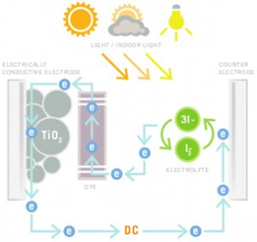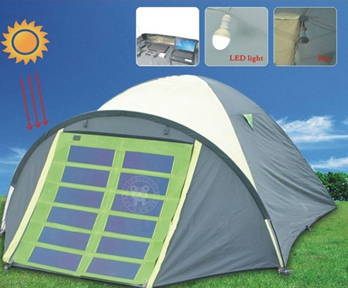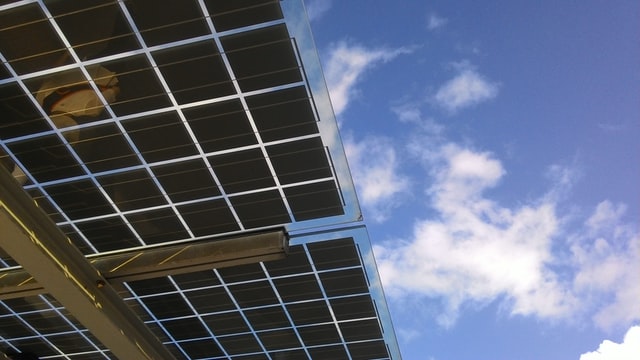Table of Contents
ToggleImagine producing electricity without the sun. That is what dye sensitized solar cells can do. This third generation solar cell can generate electricity under low light conditions. More importantly, it can do so using indoor lighting.
However, the use of dye sensitized solar cells does not come without its own challenges. Research in photovoltaic technology is ongoing to improve its relatively low efficiency rate compared with silicon solar cells.
Nonetheless, the dye sensitized solar cell has already found its way into certain practical applications, and it could be the answer to energy concerns in the future due to its many advantages.
What Is A Dye Sensitized Solar Cell?
The dye sensitized solar cell, also known as DSSC or DSC, is a distinct type of photovoltaic (pv) cell which can effectively convert natural and artificial visible light into electrical energy.
This new class of advanced solar cell mimics the natural absorption of light energy. Thus, it functions like an artificial photosynthesis micro machine.
First developed in the 1990s by O’Regan and Grätzel, DSSCs have attracted a lot of attention over recent years because of their good photovoltaic performance in low-light conditions, flexibility in terms of colors and appearance, relatively simple fabrication procedures and their potential low cost.
What Are Dye Sensitized Solar Cells Made Of?
The first materials used to make DSSCs were mesoporous titanium oxide (TiO2) electrodes prepared from colloidal TiO2 nanoparticles. DSSCs are constructed on a semiconductor.
The semiconductor of a DSSC is designed so that the nanoparticles of titanium dioxide (TiO2) are coated with a light-sensitive dye and surrounded by an iodine electrolyte.
This electrolyte is inserted between another electrolyte and a cathode. The anode is made of a glass substrate with a metal film. It is transparent, thus allowing light to pass through it.
How Do Dye Sensitized Solar Cells Work?
The working mechanism of DSC differs greatly from other types of solar cells.


- The dye functions as the photoactive material of the DSSC. When light comes into contact with the dye, photons of light are captured in the dye.
- The dye uses energy from these photons to excite electrons in the cell, behaving like chlorophyll in photosynthesis.
- The dye injects this excited electron into the titanium dioxide in the DSSC.
- The electron is then conducted away by nanocrystalline titanium dioxide (a nano-scale crystallized form of the titanium dioxide).
- The chemical electrolyte in the cell closes the circuit so that the electrons are returned back to the dye.
- The movement of these electrons creates electrical energy which is harvested into an electrical device, a rechargeable battery or super capacitor.
Pros And Cons Of Dye Sensitized Solar Cells
DSSCs have many advantages over the older types of pv cells, and are consequently used in low-density applications and portable gadgets.
However, they come with their own challenges which scientists are overcoming with recent studies and product research. Among these are the use of better materials such as porphyrin for the dye, and the creation of solid state dye sensitized solar cells.
Advantages Of Dye Sensitized Solar Cells
1. Ability To Function In Low Light And Artificial Light
DSSCs can absorb scattered sunlight and fluorescent light because of the dye used in the cells and the depth of their nanostructure. As such, DSSCs can also function in cloudy weather and low-light conditions without a significant impact on efficiency.
Other conventional solar cells would not be able to function at illumination below a certain range. DSSCs can do what other types of solar cells can because they work at wider angles and have a very low cut-off, making them appropriate for operating small devices indoors.
2. Low Cost Of Production And Materials
Dye sensitized solar cells are made of low-cost materials making them inexpensive to manufacture. Furthermore, DSSCs can be printed on any flexible surface. These factors lower manufacturing costs, making them a little cheaper to produce than other types of solar cells.
3. Resistance To Damage
Compared to thin-film cells, DSSCs do not degrade in sunlight over time. Thus, dye sensitized solar cells last longer and require less frequent replacements. DSSCs are also mechanically strong, because they are made of lightweight materials and do not require special protection from rain or abrasive objects.
4. Resistance To Heat
Other kinds of solar cells need some protection as ambient temperature rises. They heat up easily, and the internal temperature of the solar cell reduces efficiency significantly. This can result in up to 20% of energy efficiency loss.
In contrast, dye sensitized solar cells can work as efficiently at 149° F as at 77° F. This is because DSSCs are made of only a thin layer of plastic. Heat then radiates away easily, reduces internal temperature and provides for better efficiency of the solar cells.
In fact, the colour in the dye offers some protection from the afternoon sun while the cell generates electricity.
Disadvantages Of Dye Sensitized Solar Cells
1. Lower Price-To-Performance Ratio
Although the effectiveness of DSSCs is less than that of most thin film cells, the price-to-performance ratio attained through these solar cells is greater.
2. Lower Efficiency Rate Compared With Silicon-Based PV Cells
DSSCs are much closer to the photosynthetic process than standard solid-state photovoltaic devices, such as silicon based solar cells. As with photosynthesis, the efficiency of the light conversion in DSSCs depends on the relative speed of reactions.
The electron injection into the titanium oxide is much faster than electronic relaxation processes back to the ground state or chemical side reactions involving the excited state of the dye. The efficiency of DSSCs still cannot match conventional silicon-based solar cells.
3. Safety Hazard Of The DSSC Electrolyte
Dye sensitized solar cells contain a liquid electrolyte consisting of a variety of material including iodine and organic solvents. These pose a risk in terms of safety since they can be volatilized and leak outside of the cell.
There is also the issue of durability since the electrolyte can peel off the organic dyes adsorbed on titanium dioxide. For these reasons, the DSSC faces obstacles from being fully commercialised.
Use Of Porphyrin In Dye Sensitized Solar Cells
In DSSCs, photosensitizers play a major role in determining the photovoltaic response and stability of the solar cell. The use of photosensitizers based on ruthenium(II) polypyridyl complexes provides a power conversion efficiency of more than 11%. However, limitations in synthesis and production costs restrict their use.
Various sensitizers have been used for DSSCs but research activities are now focused on porphyrins due to their strong absorption bands in the visible region, versatile modifications of their core, and facile tuning of the electronic structures.
Porphyrin sensitizers show efficiencies of up to 13% in dye sensitized solar cells. A significant amount of research is being performed on porphyrin-based devices to improve their efficiency and stability with the aim toward commercialization.
Solid State Dye Sensitized Solar Cells
One of the most recent commercialised outcomes from research on DSSCs is the solid state dye sensitized solar cell launched in 2020 by Ricoh. The cell contains only solid-state materials which substantially improves the power generation capability under a weak light source.
Instead of a liquid electrolyte, Ricoh’s solid state DSSC has an organic p-type semiconductor, which is similar to an organic photoconductor. The p-type semiconductor is densely packed in the porous titanium oxide layer.
Ricoh’s solid state solid state dye sensitized solar cell generates substantially greater power under weak indoor light. It also addresses the safety risk posed by DSSCs with liquid iodine and other organic solvents as electrolytes. The solid-only structure does not have the risk of corrosion or iodine leakage.
It also has higher indoor power generation efficiency under weaker light conditions. This is attributed to its other features:
- High open-circuit voltage because the organic p-type semiconductor has an energy level deeper than that of iodine
- High short-circuit current density thanks to the organic dye chosen to suit the wavelengths of indoor light sources
- High fill factor thanks to the optimized solid-state additive and device structure
Ricoh originally developed the solid state DSSC for its multifunction printers (MFPs). However, the solar cell is also ideal for powering sensing devices, charging secondary cells and illuminating small electrical devices.
Applications For Dye Sensitized Solar Cells
Generally, the peak power production efficiency of DSSCs is about 11%, making them suited to low-density applications. The first commercial application was in 2009.
They were used in backpacks and bags in Hong Kong. Solar panels with DSSCs were built into these items to charge mobile electronic devices such as mobile phones, e-books, cameras, and portable LED lighting systems.
As DSSCs can be constructed on soft materials, the military is interested in developing this technology to make lightweight wearable solar panels that can power and recharge the electrical devices the military carry. This would eliminate the need for extra battery packs in the field or bags full of batteries.
Large modules of DSSCs can be built on tents to provide up to 1 kilowatt of energy. This would be able to power a few lights, a laptop and sophisticated equipment.


Agreenorigin solar tent
Due to the structural design and different color dyes which can be infused into the cell, the DSSC can be used on products which require transparency and a variety of colors. An example is the Exeger Solar Headphone which has DSSCs incorporated into the outer band and ear pieces to power the headphone.


Exeger Solar Headphone Bands
DSSCs can also be inexpensively built into architecture and outdoor fixtures. Windows and billboards can be incorporated with lightweight, transparent and flexible sheets or dye coat glass. On a smaller scale, DSSCs can be used to coat the lenses of sunglasses and provide power to small device batteries.
Conclusion
Dye sensitized solar cells can produce electricity under low light conditions, including indoor lighting. Furthermore, dye molecules can be modified endlessly for better performance. On top of that, it can feature different colours, and offer transparency. DSSCs are also cost effective and easy to fabricate, making them viable and efficient solar cells of the future.





